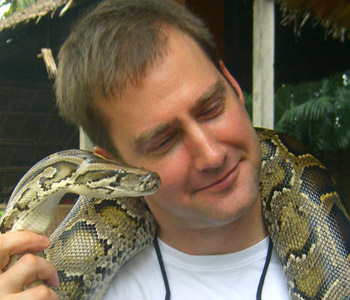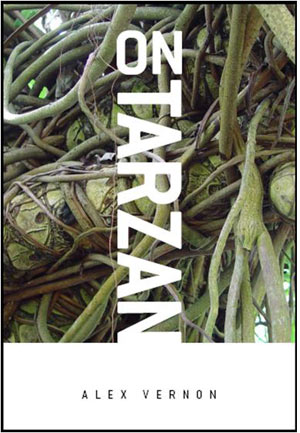
On Tarzan is the only book-length study of this pop culture icon. Historically, the book moves from the momentum of the nineteenth century and into the twenty-first. It aspires to account for the life and death of Tarzan in the collective imagination across that period.
On Tarzan also explores a particular mode of literary and cultural scholarship. I would revise the term “personal criticism,” vogue in the 1990s, to “familiar criticism,” a distinction analogous to the connoted difference between the personal essay and the familiar essay. It renders the issue one of voice and style rather than “personal” content. In terms of the content, this mode encourages playful engagement that can openly entertain subjective responses, take serious the silly, and refuse to plod .
Thus a passage on John Dereks’ 1981 film Tarzan, the Ape Man ends with the line: “But the spectacle of the spectacle is exactly the point of the film’s metaphorical critique of Hollywood culture specifically and modern U.S. media culture more generally.” Followed with a one-sentence paragraph: “Perhaps I give this film too much credit.”
(Cultural interpretation is always a risky venture, and trafficking in the ridiculous is a staple of popular culture studies, as Don DeLillo famously lampooned in White Noise.)
On Tarzan wants to see if the pursuit of dilettantism and trivia can be intellectually fruitful. Each chapter attempts to present an array of curiosities and observations without sacrificing narrative momentum or authority. The book seeks the pleasure in tangents.
“While Tarzan’s cultural significance demands a serious approach, his inherent ridiculousness heckles such efforts.”
One potential audience for On Tarzan is the American Studies classroom. Undergraduate scholars might enjoy the early discussion of the “juvenile” nature of the Tarzan narratives, the post-Darwin idea of adolescence, and the massive turn-of-the-century influx of immigrants that also informed its reception. Like fellow orphan-hero Harry Potter, Tarzan bears a forehead scar from a nearly fatal childhood battle that throbs when danger nears. As I write in the first chapter, I hope that “scholars already well acquainted with Tarzan’s place in cultural history” will find plenty of new, “provocative perspectives.”
Writing the book was a learning process, and not just in terms of the universe of narratives and artifacts I call Tarzania. Books such as Rudi Bleys’ The Geography of Perversion: Male-to-Male Sexual Behavior Outside the West and the Ethnographic Imagination, 1750-1918 and Reinhold Wagnleitner’s Coca-Colonization and the Cold War: The Cultural Mission of the United States in Austria after the Second World War proved delightful and invaluable finds.
The late chapter on the incestuous subtext of the many Tarzan narratives is hardly a thoroughgoing Freudian analysis—a task for which I am eminently unqualified. It instead takes advantage of the coeval work of Ed Burroughs, Sigmund Freud, and Otto Rank, and employs this historical conjunction toward organizing information and ideas into what aims to be a provocative story behind the stories.
The chapter also, I fear, misses an opportunity to propose a clear hypothesis concerning the coinciding of this incest discourse with the swan song of Western colonialism, the rise in the United States of the New Negro, and the invention of heterosexuality. Namely, that as the old signals of savagery and the uncivilized—skin color and sexual “perversion”—were rapidly losing their power, incest became the imagined litmus.
I am not, and never was, a Tarzan aficionado. In childhood I occasionally watched Tarzan movies (or parts of them) on television, and I think I may have caught a few episodes of the Filmation animated series from the 1970s. But, up until I decided to include the original novel in my course on American Literature and the Environment, I had never read any of the books, or any of the comics, or made any effort to see the films.
In the process of preparing for class, and through leading class discussion, I began to realize how incredibly the book transports us to early twentieth century America. As I began to muse about Tarzan’s persistence over the course of the century, I discovered to great surprise that no single book-length study of Tarzan existed. I wondered if perhaps I might be able to write that book.
So, I was pleased to read the following in one peer reviewer’s commentary on the manuscript:
Tarzan, the book argues convincingly, is sometimes Jane, and sometimes Jane is Tarzan; what looks like bestiality is often racism and homophobia in disguise… Part of the book’s appeal is that it makes clear that without understanding the galaxy of versions of Tarzan, of incarnations in narrative and non-narrative form, one cannot appreciate the multifarious uses to which Tarzan has been put. Tarzan the racist is here, but so are Tarzan the gay icon, Jane the masculine role model, and Kala the animal that radically calls the boundary between humans and animals into question. Even the imperialism that Tarzan (of British nobility born, to US liberal individualist sentiments inclined, and “Lord” of African territory made) has been argued to represent and to extend is reframed in On Tarzan in the context of the international success of the character… The phenomenon of Tarzan, the book argues, which seems so solid, simple, and reassuringly unified, derives its power instead from its paradoxical qualities—its ability to serve as a vector for different, even competing, cultural and political desires.
Not to mention this recent review in the Mooresville Tribune: “There’s an urge to say, leave my icon alone. For the bold speculator, the book is fascinating.”
Most likely someone flipping through On Tarzan at a bookstore will first notice the photographs introducing each chapter and the epigraphs. I hope this potential reader sees the humor here.
There’s the 1927 publicity shot of Tarzan-actor James Pierce greeting five Boy Scouts of different ages, “from casual youngsters to an upstanding young adult” shaking Pierce’s hand, and behind them all, forming the backdrop, a cluster of dark-skinned, spear-clutching savages—what a hysterically loaded image of white manhood in the making.
Or there’s the chapter epigraph taken from Burroughs’ Tarzan and the Lion Man, “Were I not already engaged on other lines of research, and were it possible, I should like to determine the biological or psychological explanation of the profound attraction that the blond female has for the male of all races,” spoken by the character God. Opposite this page we see Bo Derek as Jane Parker asking her father, “Daddy, is he really a savage?”
The book’s epigraphs include a line from Burroughs’ The Son of Tarzan—“Thus did the scent of Numa, the lion, transform the boy into a beast”—followed by one from Philip José Farmer’s A Feast Unknown—“It is, more than almost anything, African in its essence. Let him who would envision the soul of this ancient continent, eat lion sperm.”
I like to think this humor colors the entire book. When Boy in MGM’s Tarzan’s Secret Treasure longs to see airplanes and other modern inventions, Jane tells him to “forget about civilization. Our world here is far more lovely and far more exciting than the outside world I promise you. Now you run and get the caviar from the refrigerator.”
The film Tarzan and the Valley of Gold “gives us the most astonishing convergence of American capitalism, cultural imperialism, and violence I know, with Tarzan as the focal point, when in the Plaza de Toros, a cultural landmark, he crushes a Mexican foe with a giant Coca-Cola bottle.”
There’s the bit that reads a scene from the 2005 animated film Madagascar in terms of the of West’s imagined intersections of racism, miscegenation, primitivism, cannibalism, bestiality, and homosexuality.
And there’s the next chapter’s addition of incest to the mix, beginning with The Son of Tarzan. In Burroughs’ fourth Tarzan novel, Tarzan’s son Jack and his new friend Akut the ape “flee England aboard a steamer bound for Africa with Akut disguised as Jack’s own grandmother. ‘Outside the[ir] cabin—and none there was aboard who knew what he did in the cabin—the lad was just as any other healthy, normal English boy might have been.’ So inside the cabin he was not normal, doing things nobody knew, such as having sex with a bull ape in drag as his own grandmother”?
“I teach literature because it matters, but also because it’s fun.”
The first customer review posted on amazon.com called On Tarzan “a work of seminal and impressive scholarship.” The second called it a “piece of absolute trash” and suggested that the book be burned and Edgar Rice Burroughs, Inc. sue me for libel.
With such extreme responses, On Tarzan must do something right.
I write academic nonfiction for a professional and mostly exclusive audience, I write familiar essays for a general and mostly inclusive audience, and the potential readership for a book on Tarzan draws from both communities. While Tarzan’s cultural significance demands a serious approach, his inherent ridiculousness heckles such efforts.
On Tarzan, then, is a book-length essay, a cultural study informed by academic consideration yet at the same time familiar, speculative, and playful, embodying the ape-man’s own impossible hybridity.
Lauren Slater had a similar vision for her controversial Opening Skinner’s Box: “as an essayist, my interest was not in establishing the facts of a life but in mining the meaning, for me, of the questions that life spawned. An essayist celebrates questions, loves the liminal, and feels that life is best lived between the may and the be of maybe.”
On Tarzan succeeds for the same reasons it fails. As a kind of cultural memoir, it performs both historical inquiry and imaginative engagement. The book isn’t always sure when it is being serious, when fun. How verifiable can we take its association of the 1960s heroic reemergence and eventual collapse into parody of Tarzan with the trajectory of the U.S. war in Vietnam?
I teach literature because it matters, but also because it’s fun. I press upon my students the pleasure of inquiry and discovery and articulation. All evidence by which we arrive at opinion and judgment in literary and cultural work is circumstantial. What matters, finally, is what you can do with a text, how you can play it. Serious play, in accord with one’s historical, aesthetic, and hermeneutical conscientiousness, but play nevertheless.
After all, young Tarzan loved pulling pranks, and Burroughs had a great and healthy sense of humor too. He probably wouldn’t like this book one bit—but he should.


Alex Vernon attended the U.S. Military Academy and the University of North Carolina-Chapel Hill. The Eyes of Orion: Five Tank Lieutenants in the Persian Gulf War, won an Army Historical Foundation Distinguished Book Award; Military History magazine dubbed it “the single best book” on the war. His other memoir, most succinctly bred, was called “beautiful and smart and original” by novelist Tim O’Brien. Vernon’s primary work of scholarship on American war literature, Soldiers Once and Still, received a “highly recommended” endorsement from the American Library Association. He is currently an Associate Professor of English at Hendrix College in Conway, Arkansas.